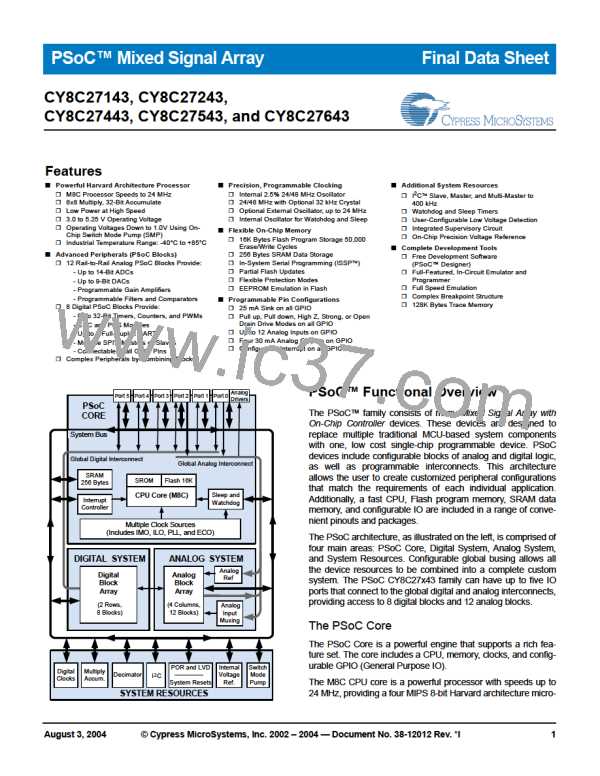CY8C27x43 Final Data Sheet
3. Electrical Specifications
2
3.4.8
AC I C Specifications
The following table lists guaranteed maximum and minimum specifications for the voltage and temperature ranges: 4.75V to 5.25V
and -40°C ≤ TA ≤ 85°C, or 3.0V to 3.6V and -40°C ≤ TA ≤ 85°C, respectively. Typical parameters apply to 5V and 3.3V at 25°C and
are for design guidance only.
Table 3-28. AC Characteristics of the I2C SDA and SCL Pins
Standard Mode
Min Max
100
Fast Mode
Min Max
Symbol
Description
Units
kHz
Notes
FSCLI2C
SCL Clock Frequency
0
0
400
–
THDSTAI2C Hold Time (repeated) START Condition. After this period, the 4.0
first clock pulse is generated.
–
0.6
µs
TLOWI2C
THIGHI2C
LOW Period of the SCL Clock
HIGH Period of the SCL Clock
4.7
4.0
4.7
0
–
–
–
–
–
–
–
–
1.3
0.6
0.6
0
–
µs
µs
µs
µs
ns
µs
µs
ns
–
TSUSTAI2C Set-up Time for a Repeated START Condition
THDDATI2C Data Hold Time
–
–
100a
0.6
TSUDATI2C Data Set-up Time
250
4.0
4.7
–
–
TSUSTOI2C Set-up Time for STOP Condition
–
TBUFI2C
TSPI2C
Bus Free Time Between a STOP and START Condition
Pulse Width of spikes are suppressed by the input filter.
1.3
0
–
50
a. A Fast-Mode I2C-bus device can be used in a Standard-Mode I2C-bus system, but the requirement t
≥ 250 ns must then be met. This will automatically be the case if
SU;DAT
the device does not stretch the LOW period of the SCL signal. If such device does stretch the LOW period of the SCL signal, it must output the next data bit to the SDA line
t
+ t
= 1000 + 250 = 1250 ns (according to the Standard-Mode I2C-bus specification) before the SCL line is released.
rmax SU;DAT
SDA
TSPI2C
TLOWI2C
TSUDATI2C
THDSTAI2C
TBUFI2C
SCL
TSUSTOI2C
TSUSTAI2C
THDDATI2C
THDSTAI2C
THIGHI2C
S
Sr
P
S
Figure 3-9. Definition for Timing for Fast/Standard Mode on the I2C Bus
August 3, 2004
Document No. 38-12012 Rev. *I
35

 CYPRESS [ CYPRESS ]
CYPRESS [ CYPRESS ]